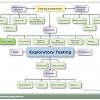 |
STAREAST 2012 Keynote: Evaluating Testing: The Qualitative Way
Video
Testers and managers have wrestled with the problem of evaluating software products and testing efforts, often using approaches derived from manufacturing, construction, and physical sciences. These approaches have been partially successful because software products aren't physical products.
|
Michael Bolton, DevelopSense Inc.
|
|
|
A Sticky Situation: Low-Tech Test Tools to the Rescue The testing craft is sometimes fascinated with high-tech, expensive tools that are intended to help managers keep up to date on what's going on. Yet, sometimes heavyweight tools aren't necessary. Michael Bolton describes how Paul Holland, a senior test manager, uses a decidedly low-tech approach to track and illustrate the testing story.
|
|
|
|
Stop Writing Test Cases! It's All About Models and Exploration With rapid application development environments and sometimes daily product releases, test cases can be an unnecessary burden on testers. Test cases are expensive to write, often fail to adequately describe interrelationships, and are ineffective for whole-team collaboration. Brett Leonard explains how you can employ software models to replace test cases as your main vehicle for test design, execution, and reporting. Using real-life examples from testing a business-to-business networking application, Brett explains two types of models to accelerate your test efforts: the simple Straight-Line Model approach and the more robust Uniform Customer Modeling language. By planning and executing tests from models, you will quickly gain an understanding of the software under test and have a new tool for collaborating with developers and all project stakeholders.
|
Brett Leonard, Construction Software Technologies (iSqft.com)
|
|
|
Questioning Measurement When we consciously measure something, we try to measure precisely and often assume that our measurements are accurate and useful. However, software development and testing activities are not subject to the same kinds of quantitative measurements and precise predictions we find in physics. Instead, our work is like the social sciences, in which complex interactions between people and systems make measurement difficult and precise prediction impossible. Michael Bolton argues that all is not lost. It is possible and surprisingly straightforward to measure development and testing accurately and usefully–even if not precisely. You can measure how much time is spent on test design and execution compared with time spent on interruptions, track coverage obtained for each product area, and more.
|
Michael Bolton, DevelopSense
|
 |
How Do You Write Good User Stories? Expert answers to frequently asked questions. In this issue, David Hussman explains how to write good user stories.
|
|
|
|
Four Paths To Predictable, Repeatable, Reusable Test Data Modern applications operate in highly integrated environments, and critical systems rely on massive amounts of data that likely contain sensitive information. Discover useful strategies for preparing your baseline, handling interfaces, designing input data, and planning for output results.
|
|
|
|
Web Security Testing with Ruby To ensure the quality and safety of Web applications, security testing is a necessity. So, how do you cover all the different threats-SQL injection, cross-site scripting, buffer overflow, and others? James Knowlton explains how Ruby combined with Watir-both freely available-makes a great toolset for testing Web application security. Testing many common security vulnerabilities requires posting data to a Web server via a client, exactly what Watir does. The Ruby side of Watir, a full-function programming language, provides the tools for querying the database, checking audit logs, and other test-related processing. For example, you can use Ruby to generate random data or large datasets to throw at a Web application. James describes common security attacks and demonstrates step-by-step examples of testing these attack types with Ruby and Watir.
|
James Knowlton, McAfee, Inc.
|
 |
Believe the Territory Test plans are seldom followed as written, project plans hardly ever fit the actual progress, and process models are rarely followed to the letter. Markus Gaertner examines why most of our documents become obsolete and gives advice about whether or not to continue to write and maintain them.
|
|
 |
Demystifying Exploratory Testing Exploratory testing is a popular approach, but many testers secretly worry they might be doing it wrong. Jonathan Kohl addresses those concerns by explaining exploratory testing in ways that testers identify with.
|
|
|
|
Agile Performance Testing Approaching performance testing with a rigid plan and narrow specialization often leads to testers' missing performance problems or to prolonged performance troubleshooting. By making the process more agile, the efficiency of performance testing increases significantly—and that extra effort usually pays off multi-fold, even before the end of performance testing.
|
|










